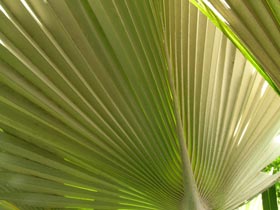Pritchardia arecina
Genus
Pritchardia
Species
arecina
Hawaiian Names with Diacritics
- Hāwane
- Loulu
- Noulu
- Wāhane
Hawaiian Names
- Hawane
- Loulu
- Noulu
- Wahane
Common Names
- East Maui Loulu
- Maui Pritchardia
Names with Unknown Sources
- Maui loulu
Distribution Status
Endemic
Endangered Species Status
No Status
Plant Form / Growth Habit
- Tree
Mature Size, Height (in feet)
- Tree, Medium, 30 to 50
Mature Size, Width
Canopy is 10+ feet with the trunk of one foot or less in diameter. [2,5]
Life Span
Long lived (Greater than 5 years)
Landscape Uses
- Specimen Plant
Additional Landscape Use Information
This is a tall growing loulu after 10+ years of growth. [Ethan Romanchak, Native Nursery, LLC]
Plant Produces Flowers
Yes
Flower Type
Showy
Flower Colors
- Yellow
Additional Flower Color Information
Flowers are showy en masse.
Additional Blooming Period and Fruiting Information
After blooming large brown to black round to ovoid (Egg-shaped) fruits, at least 1 1/4 inches wide, will develop on hairy fruiting stalks nearly as long as the leaves. [4,5]
Plant texture
- Coarse
Additional Plant Texture Information
This loulu has flat, fan shaped leaves 3 feet long with abundant hair-like fibers at the base of the leaf stalk on 4-foot petioles (portion that connects the leaf to the trunk). [2,3]
Leaf Colors
- Light Green
- Medium Green
Additional Leaf Color Information
The 3-foot long leaves are green above with the undersides covered with pale yellow to silvery gray. [2,3]
Fertilizer
Fertilize often for faster growth. [Ethan Romanchak, Native Nursery, LLC]
Water Requirements
- Moist
Additional Water Information
Moderate [1] to high amounts of water. [Ethan Romanchak, Native Nursery, LLC]
Soil must be well drained
Yes
Light Conditions
- Full sun
- Partial sun
Additional Lighting Information
Plant does best in partial shade.
Soils
- Organic
Natural Range
- Maui
Natural Zones (Elevation in feet, Rainfall in inches)
- 1000 to 1999, Greater than 100 (Wet)
- 2000 to 2999, Greater than 100 (Wet)
- 3000 to 3999, Greater than 100 (Wet)
- 4000 to 4999, Greater than 100 (Wet)
Habitat
- Terrestrial
Additional Habitat Information
Endemic to the wet forests on the north and norhteast slopes of Haleakalā, East Maui from about 1,400 to 4,000 feet. [7]
![]() Special Features and Information
Special Features and Information
General Information
There are 27 species of Pritchardia in the Palm family (Aracaceae) of which 24 are endemic to the Hawaiian Islands. [4,7]
Etymology
The generic name is named for William Thomas Pritchard (1829-1907), 19th century British counsul in Fiji, adventurer, and author of Polynesian Reminiscences in 1866.
The specific epithet arecina means Areca-like, in reference to its apparent likeness to fruit of the betel nut palm (Areca catechu). [7]
Hawaiian Names:
Loulu, pronounced low-loo, means "umbrella," because the leaves were formerly used as protection from rain or sun.
The names Hāwane and Wāhane refers the fruit or nut of the loulu, but can also refer to the palm itself. The name is also used for a small red limu or seaweed (Polysiphonia spp.). [3]
Loulu is the Hawaiian name for all species of Pritchardia in the Hawaiian Archipelago. The name has at times been misspelled as Loʻulu. However, Loʻulu, with ʻokina, is the name of the endemic Hawaiian fern Coniogramme pilosa. Loulu is also used for a species of filefish (Alutera monoceros), perhaps so called because its greenish-white skin resembled the loulu palm. It was used in sorcery to cause death because the name contains the word lou, to hook. [3]
Noulu is a variation of Loulu. [3]
Background Information
Pritchardia arecina is related to P. martii. [4]
Fossil evidence show that loulu (Pritchardia spp.) were once widely spread throughout the islands, especially in the lowlands.
Early Hawaiian Use
Loulu (Pritchardia spp.): The hard wood of the trunk of taller species of loulu were fashioned into spears by early Hawaiians.
The fruits called hāwane or wāhane were peeled and eaten by early Hawaiians. They collected young fruits. The flavor of young fruit with the soft interior is similar to coconut. The trunks loulu were notched for climbing to gather the immature fruits and fronds. Older specimens still bear notches that can be seen today. [6]
The fronds, or leaves, called lau hāwane were used by the early Hawaiians for thatching and more recently as plaiting such as papale (hats) and fans.
Additional References
[1] "Growing Palm Trees in Hawaiʻi and Other Tropical Climates" by David Leaser, page 79.
[2] "An Encyclopedia of Cultivated Palms" by Robert Lee Riffle & Paul Crafts, page 420.
[3] Hawaiian Dictionaries http://www.wehewehe.org/ [Accessed 12/30/09]
[4] "A Review of the Genus Pritchardia" by Donald R. Hodel, page S-3, S-8 S-11.
[5] http://myloulu.wordpress.com/ [Accessed on 4/20/11]
[6] "Loulu--The Hawaiian Pritchardia" by Donald R. Hodel, The Palm Journal #193, page 12.
[7] "Loulu: The Hawaiian Palm" by Donald R. Hodel, pages 1, 67.
Plant Gallery
Back to Plant List
Other Nursery Profiles for Pritchardia arecina



